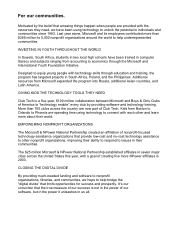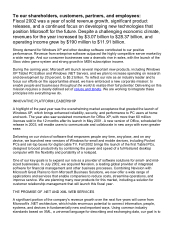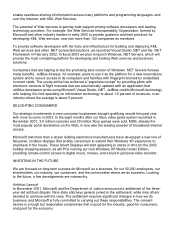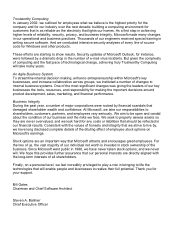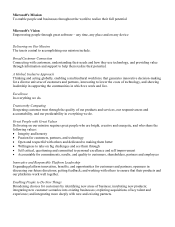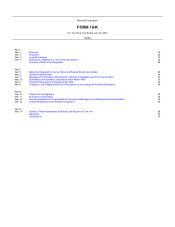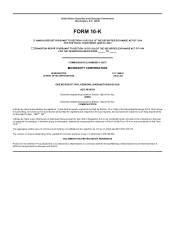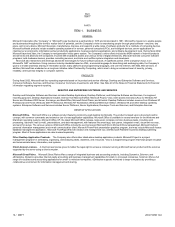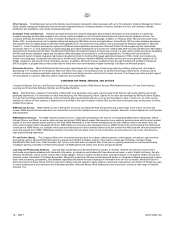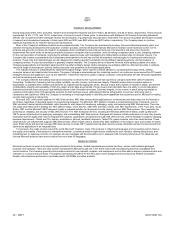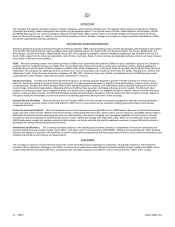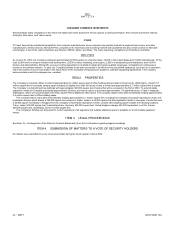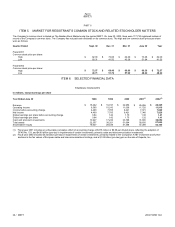Microsoft 2002 Annual Report Download - page 15
Download and view the complete annual report
Please find page 15 of the 2002 Microsoft annual report below. You can navigate through the pages in the report by either clicking on the pages listed below, or by using the keyword search tool below to find specific information within the annual report.
MSFT 17 / 2002 FORM 10-K
Part I
Item 1
bCentral. Microsoft’s small businesses portal, bCentral, includes Site Manager, a Web site management and hosting service which empowers small
businesses to easily create and manage their own Web sites, while allowing for higher-end editing in Microsoft FrontPage, and LinkExchange, which provides
services to small businesses and Web site owners to increase their online traffic and sales with free advertising banner ads on their site in exchange for
placing ads on other network sites.
DESKTOP PLATFORMS
Windows XP. Microsoft launched Windows XP in October 2001. Windows XP extends the personal computing experience by uniting PCs, devices, and
services, while enhancing reliability, security, and performance. Windows XP Home Edition is designed for individuals or families and includes experiences
for digital photo, music, video, home networking, and communications. Windows XP Professional includes all the features of Home Edition, plus remote
access, security, performance, manageability, and multilingual features to help users improve productivity and connectivity.
Windows 2000 Professional. The successor to Windows NT Workstation, Windows 2000 Professional operating system combines features to create a
mainstream operating system for desktop and notebook computing in all organizations. Windows 2000 Professional contains the enhanced business features
of Windows 98 such as Plug and Play, easy-to-use user interface, and power management and integrates the strengths of Windows NT Workstation
including standards-based security, manageability, and reliability.
Windows NT Workstation. A fully integrated, multitasking 32-bit PC operating system, Windows NT Workstation provides improved security features,
robustness, and portability. Windows NT Workstation combines the Windows 98 operating system interface and usability features with the reliability and
security of Windows NT for the business environment.
Windows Millennium Edition. Windows Millennium Edition (Me) operating system is designed specifically for home users, including capabilities to
manage digital photos and music, work with video, create a home network, and communicate with other consumers.
Windows 98. The successor to Windows 95, Windows 98 is a personal computer operating system that provides a Web-oriented user interface and better
system performance along with easier system diagnostics and maintenance. Windows 98 supports graphics, sound, and multimedia technologies and
provides the ability to easily add and remove peripheral devices and support for Universal Serial Bus (USB).
ENTERPRISE SOFTWARE AND SERVICES
Windows 2000 Server, Advanced Server, and Datacenter Server. Windows 2000 Server is a multipurpose network operating system for businesses of
all sizes. Windows 2000 Advanced Server operating system is ideal for e-commerce and line-of-business applications and provides enhanced performance
and scalability through symmetric multiprocessing (SMP) and extended memory support. Windows Datacenter Server operating system is built for large-scale
line-of-business and enterprise backend usage and supports server consolidation and enhanced scalability.
Microsoft .NET Enterprise Servers. Microsoft .NET Enterprise Servers include Microsoft SQL Server, Exchange Server, Application Center, BizTalk
Server, Commerce Server, Content Management Server, Host Integration Server, Internet Security and Acceleration Server, Microsoft Operations Manager,
Mobile Information Server, and SharePoint Portal Server.
SQL Server is a comprehensive data management and analysis platform that enables rapid delivery, dependable performance and secure operation of
connected applications.
Exchange Server is a messaging and collaboration server that provides e-mail, group scheduling, task management, contact management and
document routing capabilities.
Application Center is Microsoft’s deployment and management tool for high-availability Web applications built on the Microsoft Windows 2000 operating
system.
BizTalk Server enables companies to rapidly build and deploy integrated business processes within their organizations and with partners.
Commerce Server provides a comprehensive set of features for building scalable, user-centric, business-to-consumer, and business-to-business e-
commerce sites.
Content Management Server is the enterprise Web content management system that enables companies to quickly and efficiently build, deploy, and
maintain highly dynamic Internet, intranet, and extranet Web sites.
Host Integration Server extends Microsoft Windows applications to other systems by providing application, data, and network integration.
Internet Security and Acceleration Server provides secure, fast, and manageable Internet connectivity. It integrates an extensible, multilayer enterprise
firewall and a scalable high-performance Web cache.
Microsoft Operations Manager delivers enterprise-class solutions for operations management of Windows 2000, the Microsoft Active Directory service,
and other component services in Windows 2000, as well as other Microsoft .NET Enterprise Server applications such as Exchange and SQL Server.
Mobile Information Server mobile-enables the enterprise, extending the reach of Microsoft .NET Enterprise applications, enterprise data, and intranet
content to the mobile user.
SharePoint Portal Server extends the capabilities of Microsoft Windows and Microsoft Office by offering information workers a powerful new way to
easily organize, find, and share information. It combines the ability to easily create corporate Web portals with document management, content searching,
and team collaboration features.


